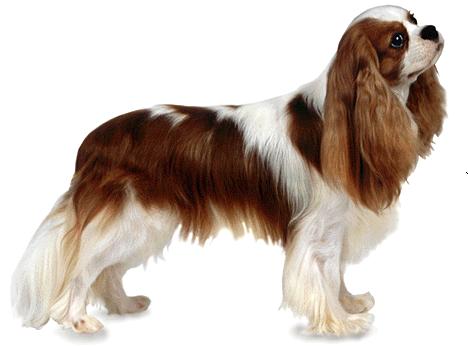Cavaliers are known to have a single coat, which means that they do not produce the dense type of undercoat that breeds like Huskies and German Shepherds do. Some of them do not produce an undercoat at all, but most adult Cavaliers will produce at least a small amount of undercoat. This undercoat needs to be removed, or combed out, during grooming because the fuzzier texture of the undercoat leads to matting and tangling, particularly behind the ears and in the long feathering.
Many tools are designed to remove the undercoat, but the best of all is a fine-toothed metal comb, which will gently remove it without cutting or damaging the outer coat.
The Grooming Session
Grooming an adult Cavalier is much like grooming a puppy, but with much more dog to work on. Begin the grooming session by standing your Cavalier on a grooming table or counter top covered by a nonslip surface. Next, check the entire coat for mats that need detangling. Comb gently through the coat using a fine-toothed comb. After you have combed through the body fur, move on to the head. Starting at the top of the ears, work the comb gently through the fur, being careful not to touch the eyes.
If mats are to be found, they are usually located at the small pocket under the ear where the ear connects into the neck, although they can be found on the surface of the ear or the underside of the ear as well. If the fur is matted there, it will need to be combed out gently, working the tines of the comb into the fur at the edges of the mat.
Detangling products can be very useful in making a grooming session more comfortable for your dog. If you choose to use a detangling product, spray it on the mat and use your fingertips to work the product through it before attempting to use the comb. Once the mat has been removed, use the smaller fine-toothed to remove the remainder of the fuzzy undercoat from around the mat. Be vigorous in the removal of any undercoat in this area.
If your Cavalier consistently develops matting around the ears, take him in for a vet check to rule out infection or parasites. Continue on to the other ear and then move on to the bib, the fur at the throat and neck.
On younger dogs, the bib rarely mats, but on older dogs the mats under the throat area can be quite large and dense. If your dog is developing a lot of matting at the bib, consider removing his collar or any tags that dangle in front of it. Metal rabies and licensing tags can cause a grayish discoloration of the fur at the bib, and collars that cause the dog discomfort and scratching can lead to matting at the bib area. Using the fine-toothed comb, gently comb through the bib until the comb can be brought through the entire area without catching on either mats or undercoat.
As you proceed along the body, use your hands to feel under the arm pits and through the long feathering on the feet and legs. If the mats can be removed using a detangler and a comb, simply remove them. If they are too deeply matted, it may be more comfortable for the dog to have them cut out using blunt-tip scissors with caution. Of course, if you are showing your dog, you will not want to cut the coat—even a single hair of feathering is valuable to a show dog.
Next, turn up the feet and check the pads of each foot. Trim the hair between the pads, exposing the surface of the foot pads. This allows your dog to have better traction and a safer, more comfortable walk. It also fosters good hygiene in the feet. Check between the pads for any sharp objects that may be causing discomfort. The undersides of the feet may be trimmed with small electric clippers or blunt-tip scissors. You may trim the nails at this time. After the feet and legs have been combed through and the pads of the feet have been trimmed, it is time to move on to the abdomen and the hind legs.
The rear legs are another frequent location of matting on Cavaliers, especially the area going down the rear legs within the long feathering found on the outer surface of the hind legs. Even puppies can form mats there. The skin on the back legs is very sensitive, and removal of mats from that area can be both difficult and painful for your dog.
It is far better to prevent the mats from forming by running your hands and fingers through the coat daily and working on small problem areas as they form. If your Cavalier is not going to be shown, there is no reason why you can’t take him to a groomer from time to time to clip the hair on his legs down to prevent matting.

